The Geekiest Moments in Futurama History
We voyage back to the world of tomorrow in search of Futurama’s most obscure and intelligent moments…
You don’t have to be trapped in a cryostasis pod for time to pass unnervingly quickly. Instead, why not just remind yourself that it’s been close to twenty years since we hung out with the Planet Express crew!
Luckily, the dry spell of Matt Groenig characters ended in 2018 with Netflix’s Disenchantment, an animated series that’s set to do for fantasy what Futurama did for science-fiction. Still there’s no replacement for the original, pure, uncut Futurama. That was a show staffed by writers with degrees in Computer Science and Applied Mathematics, who gleefully plumbed the depths of their geekdom for obtuse references to delight a tiny fraction of the audience. Here are a few of the most esoteric examples…
The Twilight Zone
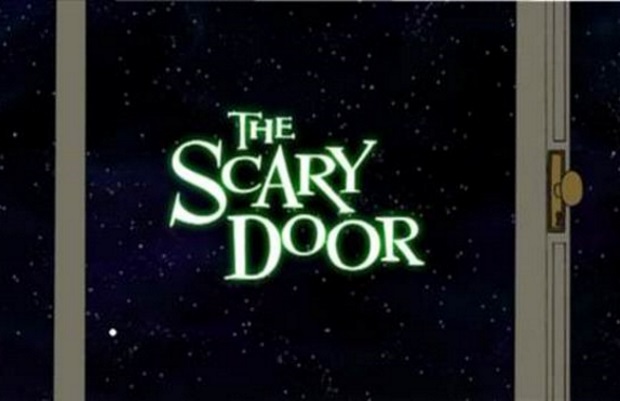
It looks like television archiving hasn’t gotten any better by the 31st century as no-one, not even telly-addict Fry, has noticed the striking similarity between New New York’s popular sci-fi horror show The Scary Door and a certain other show. The spooky satire makes an appearance in most seasons and it’s always a treat to see.
Futurama’s fondness for The Twilight Zone goes far beyond its in-universe homage, though. When Bender takes over Chef duties aboard the good ship Planet Express, he’s quick to don an apron that reads “TO SERVE MAN” – a Twilight Zone episode also riffed on by the first Simpsons Halloween special. Similarly, the vignette Terror At 500 ft, where a giant Bender visits Earth, can be taken as a nod to the seminal ‘monster on the wing’ episode “Nightmare At 20,000 Feet”
read more: The Twilight Zone Marathon: A History of a Holiday Tradition
Perhaps the greatest homage of all is the premise of Futurama’s final episode, “Meanwhile,” the third act of which sees Fry accidentally breaking a device that causes time to become permanently frozen – precisely what happened to loudmouthed Patrick McNulty in the Twlight Zone episode “A Kind of a Stopwatch.” Happily, since he’s still got Leela at his side, Fry accepts the prospect of an eternally-immobile universe with a tad more dignity…
Video games
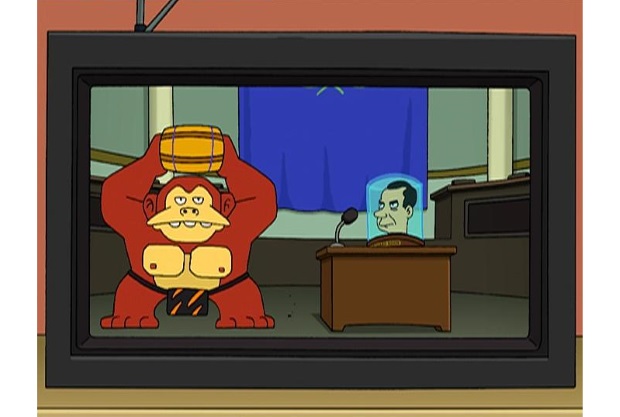
Given that the opening shot of Futarama’s very first episode stars none other than Donkey Kong, it’s no surprise that the show contains a fair few references to the computerised classics of yesteryear. Having grown up in the 1970s, Fry has an extensive knowledge of retro games – although his Space Invaders skills are questionable – and he’s able to hold his own when the Planet Express crew head online for a quick round of Death Factory III: The Legend Of Death Factory II.
The writers’ love of games from that era is equally apparent, particularly in the multi-part episode “Anthology of Interest“, which sees Earth invaded by an assortment of belligerent 8-bit icons seeking quarters. One of these is Q*Bert, star of his eponymous arcade game that saw the little orange critter – apparently – launching into a censored frenzy of expletives whenever something collided with him.
read more: How Space Invaders Became a Gaming Phenomenon
While it’s never been made explicitly clear that Q*Bert was swearing (staunchly PG movie Wreck-It Ralph would have us believe it’s just his alien language) courtesy of his Futurama appearance, we finally have some idea of what he might be saying. Taking his one line of dialogue and playing it back reveals that the amiable alien is really asking “Where can a guy get some pants around here?”
Star Trek
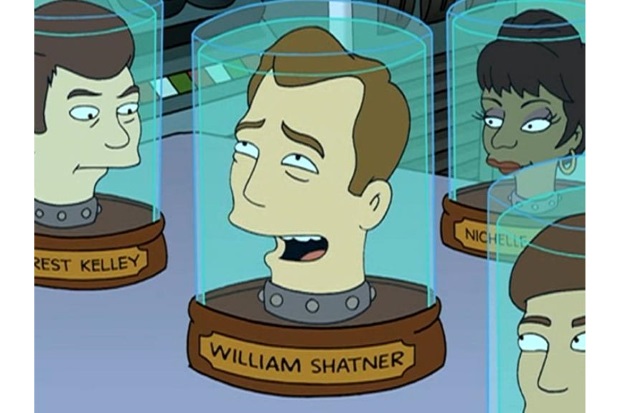
Despite Matt Groening’s insistence that he’d never seen an episode of Gene Roddenberry’s opus – much to the horror of his commentary bedfellows – Futurama is littered with all the sly digs and parodies you’d expect from a sci-fi comedy. The second season episode “The Deep South”, in which Bender declares that his ass has been designed to act as a flotation device, actually manages to feel less farcical than the moment of Star Trek Insurrection it’s riffing on.
It’s The Original Series that gets the most attention though, and it’s a love affair that peaked in the show’s fourth season by reuniting most of the Star Trek cast – even William Shatner, who’s previously been cited as the first celebrity to turn down The Simpsons.
read more: The Influence of the Forbidden Planet on Star Trek and Star Wars
Trek fans will get a kick out of call-backs to classic episodes like “Metamorphosis” and “Who Mourns For Adonis”, but there’s one particularly deep cut that’s easy to miss when George Takei and Walter Koenig have to share a fan-script provided by energy being Melllvar* – one of several real-life indignities suffered by the pair during Star Trek’s second season, along with cohabitating in the same dressing room. At least they’re able to laugh about it now, eh?
* Three Ls, for those of you who’ve never been to a convention before.
Alienese
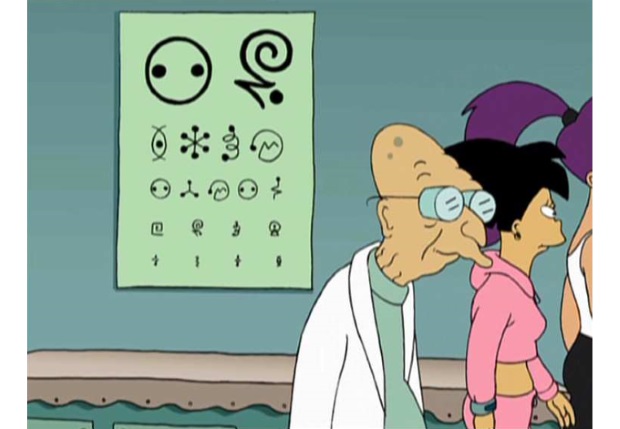
Freeze-frame bonuses, known colloquially as sight gags by the writers, enrich almost every scene in The Simpsons, from shop hoardings to movie theater posters that flash past too quickly to read and were designed to be picked up by dedicated fans on their VCRs.
Having already decided that Futurama would be a show that would seed future stories and ply the audience with mysteries to discuss, the producers decided to go one step further with their sight gags: they introduced “Alien Language One” into the show. This was a simple cypher that replaced English characters with extra-terrestrial symbols on various signs and other details, and the producers hoped that eventually, fans would be able to figure it out.
The pilot episode hadn’t even finished airing by the time the solution was posted online. Chastened, the team went back to the holographic drawing board and created a second, more complicated language. This one took a little longer to crack, but the internet’s persistence won out in the end and the sight gags flowed freely once again.
After the show’s run, showrunner David X. Cohen revealed that the writers had actually created a third code that ultimately went unseen. Their reasoning: home computers would have to improve first, or there was every chance that the code wouldn’t be broken within the producers’ lifetimes. With great brainpower comes great brainsponsibility, as Professor Farnsworth might say.
Maths and computing
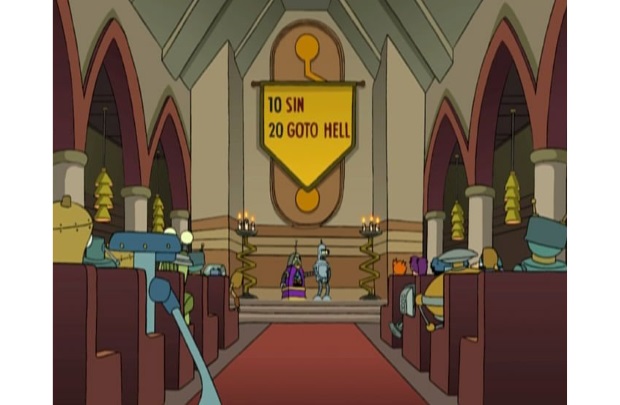
Futurama’s robots, from the egomaniacal Calculon down to hobbling orphan-bot Tinny Tim, provide plenty of opportunities for gags about programming and computers in general. Anyone who remembers the old programming language BASIC can get a smirk out of “10 SIN, 20 GOTO HELL” inscribed at the Church of Robotology, though not everyone will lunge for their scientific calculators to work out why Bender’s so terrified when the message ‘0101100101’ appears in blood during the events of “The Honking.” (In the mirror, it’s ‘1010011010’, or ‘666’ for those of a decimal persuasion.)
Peak geek, however, arrives with the Season 7 episode “The Prisoner of Benda“, a body-swapping romp with a twist – once two individuals have swapped minds, they can never swap again. To help prove to the rest of the staff that sorting everything out required just two extra bodies in the mix, writer Ken Keeler put his PhD to work to create a mathematical proof that came to be known as The Futurama Theorem – the first time such a work was created for the purposes of entertainment.
Impressive stuff, but given Keeler had already won the show an Emmy by penning the song “I Want My Hands Back”, it’s hard not to wonder what else the show’s writers might have accomplished by now if Futurama had lasted as long as The Simpsons. World domination doesn’t seem out of the realms of possibility…
